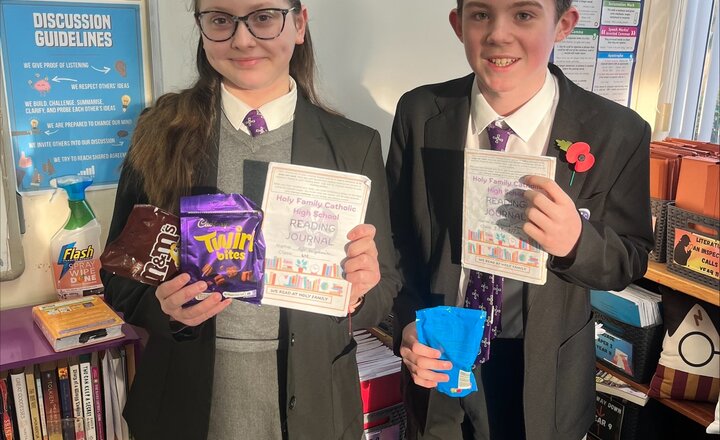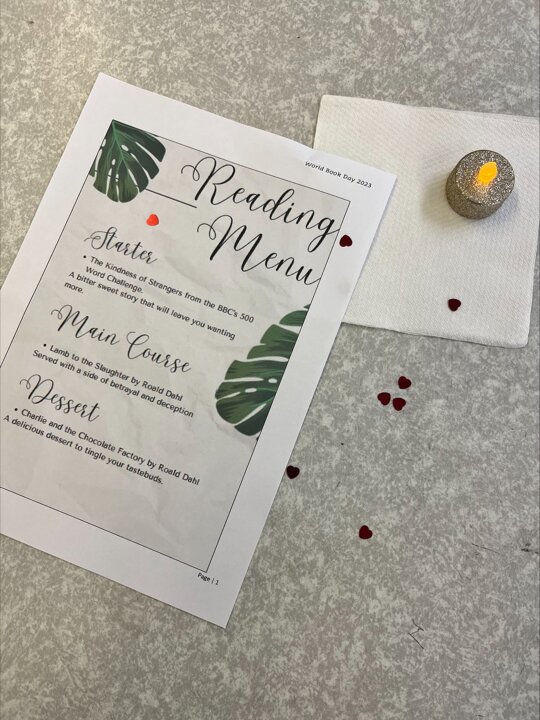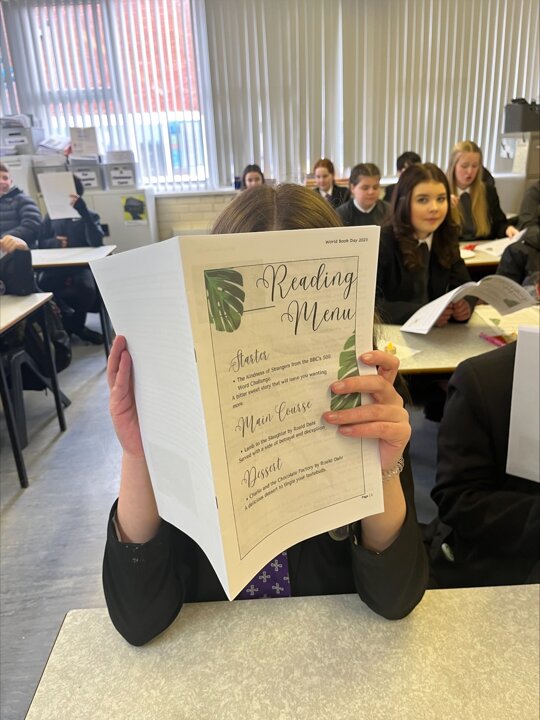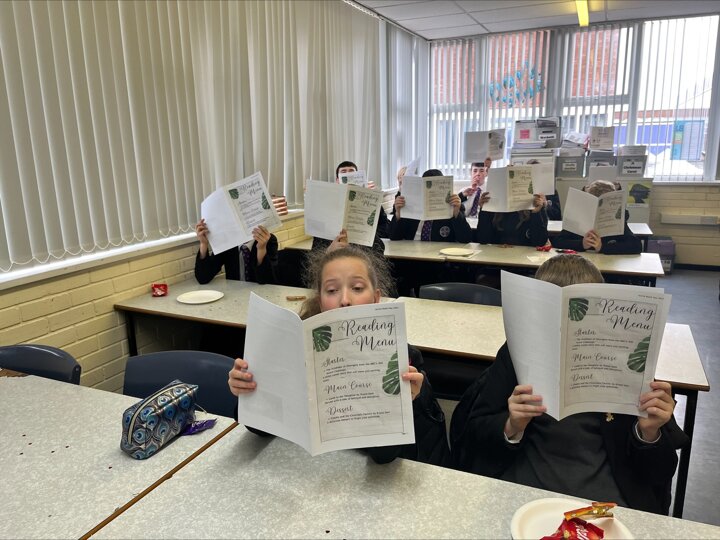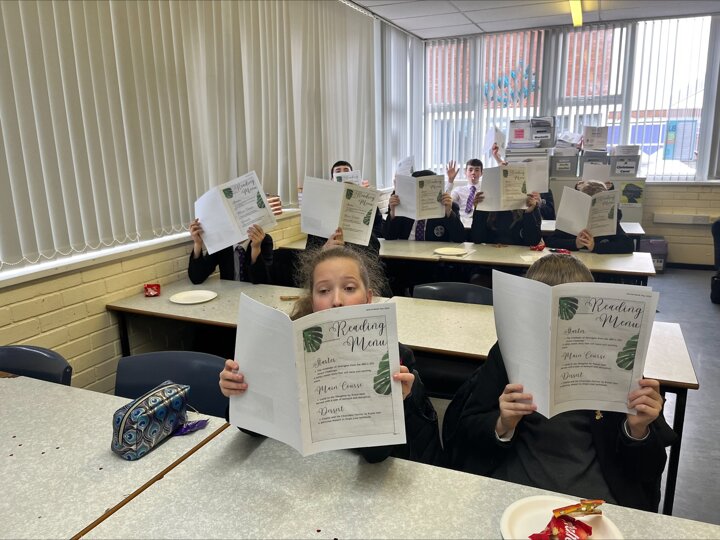Reading
Reading is the thread in all that we do.
We understand the importance of every pupil, no matter what their starting point, reading confidently and fluently. We recognise that reading for learning is at the heart of everything we do and is therefore a whole-school priority in every subject. Our aim is for all pupils to be reading above their chronological reading age - enabling them to confidently access the KS4 curriculum and achieve success in their exams.
Our whole-school reading programme is Sparx Reader. All pupils from Year 7 -11 read weekly in form time and then at home, having selected their own book from the extensive Sparx library. Pupils collect Sparx Reader Points SRPs as they read carefully, and we encourage them to gain at least 300SRPs a week.
Our reading Governor is Mrs Claire Dunn, she supports the reading leaders (Deputy Head Teacher, Quality of Education, Reading Intervention Leader, and Reading for Learning Leader) to drive the reading strategy which is explained in this document.
A good level of reading is essential for pupils’ acquisition of knowledge and their ability to make connections between the things that they know, both within and across their subjects. The average reading age required to access GCSE level texts and examination papers is almost 16 years. We therefore have a comprehensive and rigorous approach to reading within subjects, which ensures that our pupils develop the knowledge, vocabulary and reading fluency to access the curriculum and their exams, and that they leave school with sufficient reading skills for future learning and employment.
We ensure that our pupils read widely and constructively, and pupils’ reading supplements our curriculum to ensure that pupils leave us with sufficient knowledge and cultural capital to succeed in life. Our approach to reading develops pupils’ reading skills, comprehension, and accuracy, builds their confidence and develops an enjoyment of reading. To create our reading strategy, we have drawn on expertise and training as well as current research including The EEF ‘Improving Literacy in Secondary Schools’.
Reading Strategy Summary Document
Reading List
We recommend the following websites to support your child reading at home:
A Love of Reading
Building confident readers
Evidence suggests that there is a strong positive relationship between reading frequency, reading enjoyment and attainment. It is an important part of school life at Holy Family, that we promote regular reading, particularly with pupils who are reading at below age-related expectations. We believe that all teachers and staff have a responsibility to promote reading by exposing pupils to a wide range of novels, non-fiction texts, poems, scripts, newspaper, and magazine articles.
We have a reading room which is replenished frequently and all pupils at KS3 have a weekly reading lesson. Reading lessons ensure pupils hear and read sustained and challenging texts at least weekly. This regular exposure develops an understanding of the world around them and immerses them in a diverse range of texts that develop the vocabulary they need to effectively express themselves. In reading room lessons, we cultivate the behaviours needed to be discerning readers as pupils read frequently and widely using self-regulation strategies and discuss what they read. Reading room lessons deliberately increase opportunities for reading, which increases fluency and stamina, which in turn increases pupils’ enjoyment of reading.
In the KS3 English curriculum, all pupils read at least two complete novels of increasing complexity starting in Year 7 with The House with Chicken Legs by Sophie Anderson, building up to Long Way Down by Jason Reynolds and Heroes by Robert Cormier in Year 9.
Our school Reading Patron is Simon Adepetun who holds creative writing workshops as well as promoting reading with our pupils. https://simonadepetun.co.uk/
We offer the pupils a varied diet of enrichment centred on a love of reading. For example, we invite ’The Book People’ into sell books and allow pupils to use the book vouchers that they have earned. We host events by visiting authors, challenge pupils with reading competitions, go on visits to the local and central library and book shops. We also share book reviews with pupils and parents on social media.
Teachers encourage pupils to talk about what they are reading and reading activities regularly take place in form time.
The school supports parents in many ways including publishing a list of recommended books on the school website, a regular Parent Reading Newsletter and information to encourage parents to support reading at home.
Reading Intervention
Reading assessment and identification of need
Pupils undertake the Sparx Reading Assessment every year which takes place in form time and takes approximately forty minutes. If a pupil shows as having reading difficulties, they are asked to read with a specialist reading teacher and they carry out The Salford Reading Test to assesses a pupil’s reading accuracy and comprehension ability using sentences aligned to the National Curriculum. It generates a reliable reading age, comprehension age and, by hearing reading, we can spot any pupils who are not confidently decoding words.
The reading age is communicated to all teachers on Class Charts so that they can use this information to seat pupils and support pupils appropriately.
All pupils have their reading re-assessed each year using the Sparx Reading Assessment. This online assessment takes place in school with the support of the teacher and a reading leader. The assessment takes forty minutes and produces a reading age and a detailed report about the strengths and areas of weakness for each pupil. This information is shared with the SENDCo and class teachers on Class Charts.
Reading intervention
The Salford and Sparx Reading Assessment flag up pupils who need support with reading. A low reading score immediately triggers a tiered approach led by our reading intervention team. All staff have had phonics training to enable them to successfully deliver intervention. Where a decoding issue is identified, the SENDCo will consult parents and may offer a SEND screening assessment. If a parent has any concerns about their child’s reading, they should contact Kate Samra k.samra@holyfamilyhighschool.co.uk
Red readers – Phonics intervention.
If a pupil cannot confidently decode words, we deliver a secondary school systematic, synthetic phonics programme called Fresh Start Phonics (Read Write Inc.). It is well-structured so that it meets the needs of the National Curriculum. This is supplemented with our own resources and reading materials so that we can provide secondary age-appropriate books.
Red readers begin with 1-2-1 support moving to small group intervention when ready. Frequent, low stakes assessments help the teacher to tailor the programme according to need. Time is given in the timetable to support this. As part of the intervention, we ask pupils to take reading books home and complete a reading record. We ensure the reading books match the sounds and letters, so they are appropriate and help to build up fluency.
A workshop with parents of red readers further supports reading at home. This is typically held in the first term of Year 7.
Amber readers – fluency and comprehension.
Amber readers can decode successfully but may have some issues with fluency and comprehension. This may mean they read more slowly than some of their peers, or struggle to understand words.
Amber readers are identified to teachers and given extra weekly practice and small group intervention.
Retested more frequently to monitor impact.
Link to Fresh Start Phonics
Reading for Learning
Reading for learning in lessons (Disciplinary Literacy)
It is the responsibility of all teachers to teach pupils how to read within their subject area. This is a whole-school priority and, to aid this, we have a ‘Reading for Learning’ Leader who promotes and co-ordinates our whole school approach. All teachers have received ongoing professional development in reading for learning strategies to use in the classroom.
The subject curriculum has been broken down into component knowledge – bitesize pieces of knowledge that pupils need to know to make progress. A key component of this is for teachers to clearly identify subject specific vocabulary which pupils must know to make progress. The identification of subject specific vocabulary, along with specific strategies to support pupils to read and understand, is detailed in each Subject Curriculum Map.
To help pupils actively engage with what they are reading we focus on two techniques - reciprocal reading and ‘read alouds’. Read alouds are methods to hear expert reading aloud in a variety of ways including using a visualiser, choral chanting, ‘I say, we say, you say’ and other methods.
At Holy Family we have embedded reciprocal reading into our classrooms, in all subjects. It is a structured method of guided reading where children are gradually taught to develop reading skills to explore and find meaning in texts. Reciprocal reading supports independent comprehension skills and is a structured approach to reading which students can use to improve their reading comprehension.
Reciprocal reading is a great way to teach students how to determine important ideas from a text while discussing vocabulary, developing ideas and questions, and summarising information. There are four parts to improving reading comprehension and engagement, which are called ‘The Fab Four’:
- predicting
- questioning
- clarifying
- summarising.
Each one of these plays an important role in helping students:
Improve literacy — Rather than skipping over words they don’t understand, students are encouraged to figure out what they mean, helping them with current and future readings.
Stay engaged — Students are actively looking for different clues and ideas throughout readings, helping them to stay interested in a text.
Boost reading comprehension — The four building blocks give students the tools needed to decipher a text and understand the ideas being presented to them.
Learn on their own or in groups — Reciprocal teaching puts students in the position to improve their reading comprehension through teamwork so they are better suited to work by themselves on future projects.
.jpg)
Home Learning Resources
Related News
